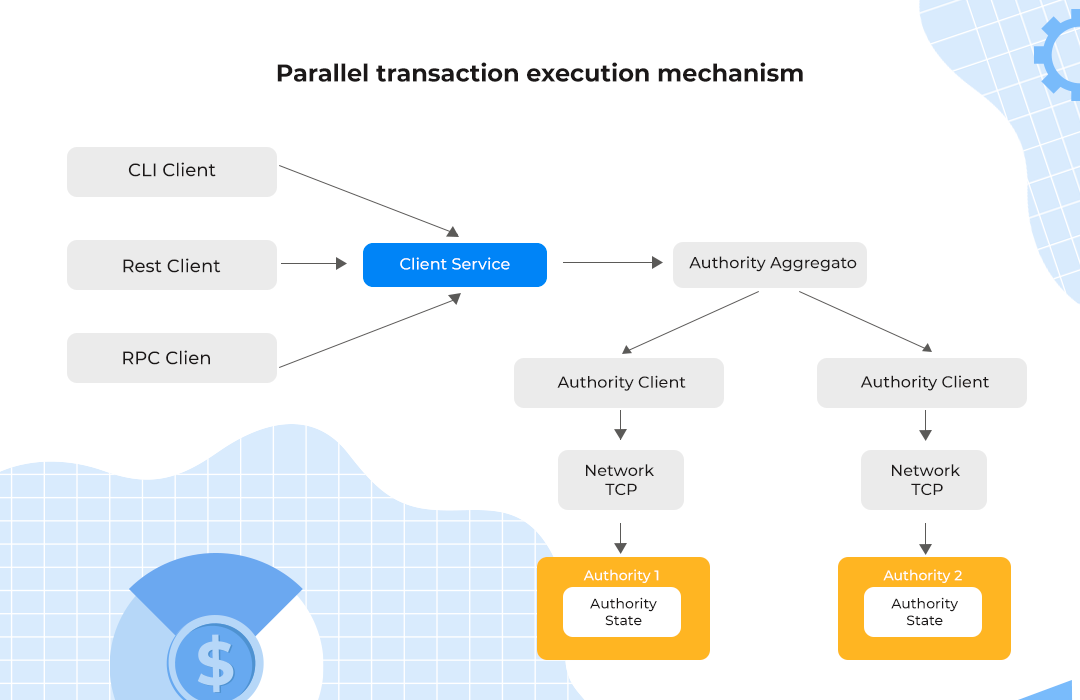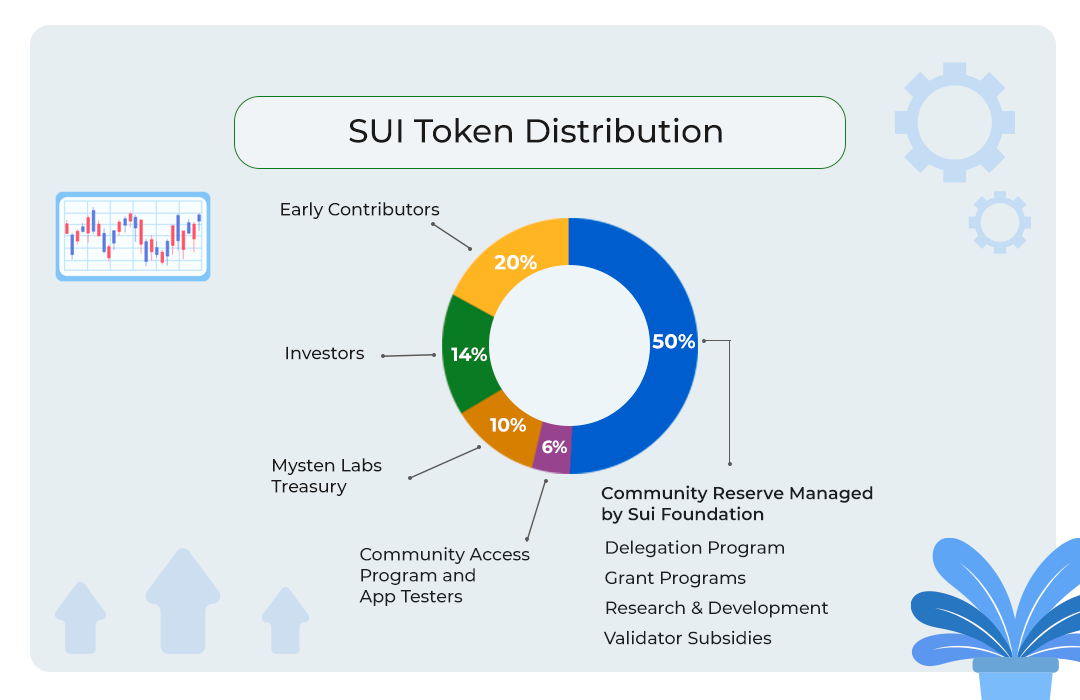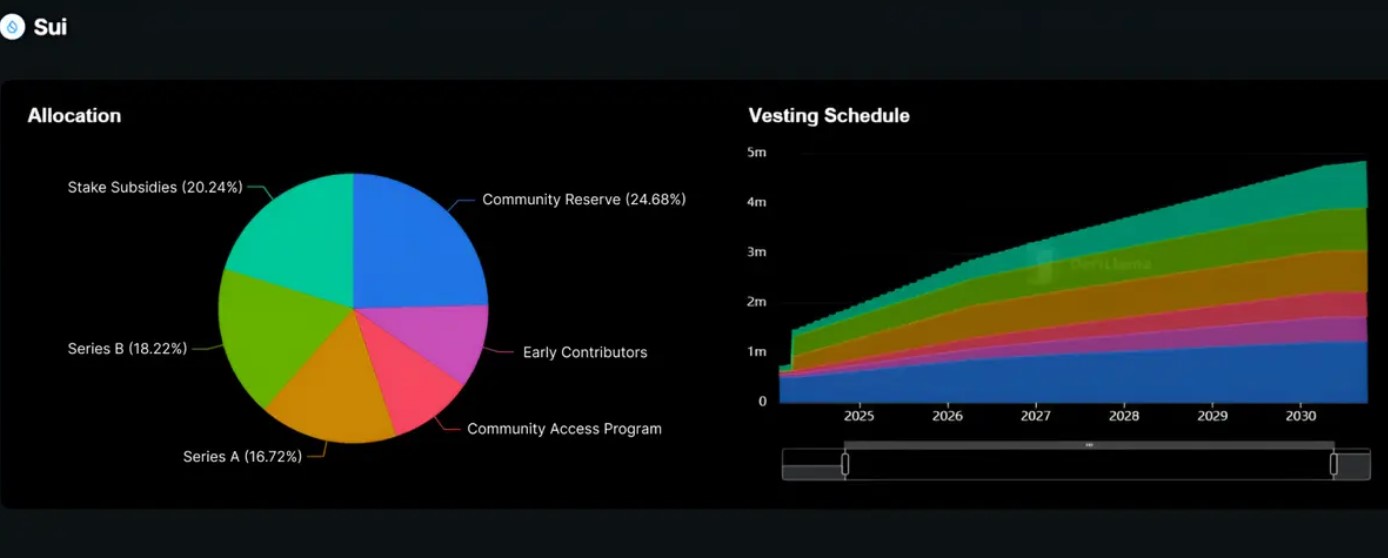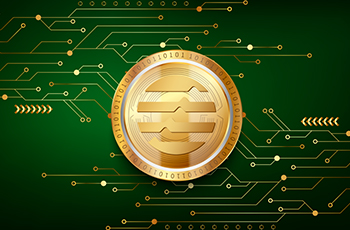What you need to know about the Sui blockchain?
We talk about the prospects for an innovative, high-throughput Layer 1 blockchain platform

01.01.2023
3844
11 min
2
Sui Network is a Layer 1 (L1) blockchain platform from Mysten Labs. The project positions itself as a competitor to the Aptos network, which uses the same programming language (Move) and was also created by former Meta employees.
The Wave 1 testnet was launched on November 17, 2022. Mysten Labs stated that the blockchain has high scaling potential and in the future will allow developers to “build experiences that cater to the next billion users in web3.”
Content:
- Features of Sui
- History of creation
- Sui architecture
- Transactions
- Sui tokenomics
- Airdrop: one of the simplest in history
- Application development
- Why are Sui and Aptos compared?
- Project outlook
Features of Sui:
| Title | Sui |
| Year of launch | May 2023 |
| Native token ticker | SUI |
| Explorer | https://suiexplorer.com |
| Whitepaper | https://docs.sui.io/paper/sui.pdf |
| Developer website | https://sui.io |
| Official social networks | |
| Where is it traded | Major exchanges, including Binance, Bybit, OKX. |
History of creation
Mysten Labs was founded in September 2021 by former employees of Novi Research. It is a division of Meta Corporation, which developed the canceled Diem blockchain and the Move programming language. The company’s CEO is Evan Cheng, the former director of research and development.
The Sui network was first publicly unveiled in March 2022, with work on it starting back in the fall of 2021. Mysten Labs managed to raise $36 million from venture capital fund Andreessen Horowitz (a16z) earlier this year and another $300 million in a Series B funding round in September. The company is currently valued at $2 billion.
Cheng said in one of his addresses that “current web3 infrastructure is in the dial-up era – it’s slow, expensive, capacity constrained, insecure, and simply hard to build for.” According to his plans, Sui is supposed to be a high-throughput blockchain that will drive industry-wide growth by allowing users to seamlessly interact with any product on the network without intermediaries.
Sui architecture
According to the Sui technical documentation, the blockchain consists of three main components:
- Objects. This is the basic unit of storage on Sui. They are created and managed by Move packages, as the developers call smart contracts. In this, the smart contracts themselves are also objects. Thus, data on the network falls into two categories: mutable (Move objects) and immutable (Move packages).
- Transactions. They are used to record all the changes in the network in the Sui ledger.
- Validators. The entire network and transactions are processed by independent validators. Each of them runs its own instance of the Sui software on a separate device.

The blockchain uses a Proof-of-Stake (PoS) consensus algorithm. In Sui, the data structure is distributed through parallel transaction processing, which enables faster, lower-cost transactions and minimizes the risk of double-spending. The same mechanism is offered by competitor Aptos.
Transactions
A typical blockchain transaction is a user-to-user transfer of data, and Sui is optimized for this scenario. The protocol distinguishes between two types of assets: personal, which can only be modified by the holder, and shared, which has no specific holders and can be modified by more than one user.
Therefore, the method of transaction processing depends on the type of asset. If it is owned assets, such as token transfers, NFT issuance, or voting participation, they are processed in a simpler way by the Fast Pay method. It is based on the Byzantine Consistent Broadcast mechanism, which involves four steps:
- A transaction is sent to a node, which will subsequently transmit its data to a validator
- Validators verify the transaction and validate it, notifying the sender
- Already sender creates a certificate, which must contain the signatures of at least 2/3 of the network validators
- The sender gets a certificate with details of the transaction, if necessary
In this case, there is no need to find a consensus between validators, so the transaction is performed faster.
If the operation is related to shared assets, then the transaction will have an additional step — finding the same consensus between validators. To do this, the Sui Consensus Engine is used, which consists of two components: Nurwhal and Bullshark (sometimes the older Tusk technology is used instead).
Narwhal is a mempool, which is responsible for the preservation and availability of the data to be checked, while it has a high throughput.
Bullshark is a protocol that allows consensus between validators without the need to exchange information between them.
One of Sui’s most interesting features for scaling is parallel transactions. On most blockchains, validations are executed sequentially, which reduces competition between transactions and eliminates double-spending but limits throughput.
Parallel transactions make confirmation speeds lightning-fast. This method allows Sui to process up to 297 000 transactions per second (TPS), compared to only 7-15 transactions per second on the Ethereum network. More complex transactions, which require consensus between validators, take slightly longer - 2-3 seconds.
Sui tokenomics
SUI is the native token of the Sui blockchain. Its total supply is limited to 10 billion coins. There are currently 1 165 931 966 tokens in circulation. Part of the maximum supply was planned to be distributed among developers, investors, and community members. A share of the coins went to the Sui custodial fund, which will pay rewards for validators. Also, a significant portion of the funds will be sent to the Sui Foundation, an organization independent of Mysten Labs, which is going to fund future events and developments.

SUI token distribution after blockchain launchSource: Sui.io
According to the project team’s plans, the coins are distributed as follows:
- 50% of the tokens are allocated to the SUI network community, including staking and validation rewards.
- 20% of the tokens are allocated to participants of the public sale.
- 14% of the tokens are allocated to investors and sponsors who supported the SUI blockchain in its early stages.
- 10% of the tokens remain at Mysten Labs for further development and project management.
- 6% of the tokens are reserved for rewards to testers and ambassadors who help promote and test the SUI ecosystem.
The SUI token serves several functions:
- A means for payment, exchange, and accumulation
- Payment of fees;
- Acts as an entitlement for holders to participate in project management through voting;
- Staking and collateral for validators
SUI token unlocks until 2030:

The blockchain also has its own wallet — Sui Wallet. It is available as an extension for the Google Chrome browser and performs all the basic functions. Users will also be able to restore their old wallet using a seed phrase. With it, it will be possible to manage all types of assets, including NFTs, as well as interact with decentralized applications (DApps).
Airdrop: one of the simplest in history
The airdrop held on the Sui platform was recognized as the most significant event by Binance.
The conditions for participation in the distribution were extremely simple: you only needed to join the Discord channel of the project until February 1, 2023. As a reward, participants received a distribution of 1500 SUI tokens to their accounts. Once the tokens were listed on exchanges such as Bybit and Binance, they could be sold at a price in the range of $1700-$1800.
Airdrop thus became probably the easiest token distribution in 2023. More information about the Airdrop process can be found on the official website of the project.
Application development
Mysten Labs says that developers will have many different tools at their disposal that will allow them to create DApps and other Web 3.0 projects with an improved UX design. The types of applications Sui supports:
- Decentralized (DeFi) and Traditional Finance (TradFi)
- Bonus and loyalty programs
- Integrated gaming and business solutions
- Asset tokenization services
- Decentralized social networks
- Non-fungible tokens
In August, the official SUI resource published data on 86 different initiatives in its ecosystem. Among them, we can highlight 16 DeFi projects, 23 GameFi projects, 15 NFT-related initiatives, and 8 projects in the SocialFi category. DeFi apps Cetus and Porto Labs, and NFT-based marketplace Blue Move have emerged from the network. In addition, the blockchain is linked to cross-chain bridges Wormhole and Axelar Network. It has also announced the development of several blockchain games, F1 Dog, Trial Xtrem, and Netmarble.
Why are Sui and Aptos compared?
Sui and Aptos emerged as an extension of Facebook Diem’s blockchain initiative, with a focus on increasing TPS, scalability, and security. Both blockchains utilize the Proof-of-Stake (PoS) consensus algorithm, enable parallel transaction execution, and are written in the Move language.
| Sui | Aptos | |
| Language | Sui Move | Move |
| TPS | 120,000 | 160,000 |
| Time to finality | <1c | <1c |
| Consensus | parallel processing
Narwhal и Bullshark |
parallel processing
AptosBFT |
| Inovation | gas and transaction
storage mechanism |
hybrid castodial options and
prior execution of transaction |
| Hardwarerequirements | CPU: 2 core
RAM:8gb Storage: 50gb |
CPU: 4 core
RAM: 32gb Storage: 500gb |
However, the Move implementation in Sui offers a more explicit API for managing ownership rights, while the ownership mechanism in Aptos is less detailed. Also, the underlying algorithms on which they are built differ significantly. For example, Aptos uses BlockSTM to enable dynamic parallelism and task execution, while Sui employs a mempool based on DAG, Narwhal, and Tusk, which facilitates parallel transaction processing and improves defense against DoS attacks.
Regarding scalability, Aptos emphasizes validator diversity to achieve high scalability performance, while Sui realizes scalability through data store segmentation and horizontal increase in computing resources.

Is it worth investing in Aptos? What you need to know about the project
Experts evaluated the development prospects of the new ecosystem and the investment attractiveness of its token
Project outlook
SUI stands out as one of the most attractive L1 projects in the current cycle. Several key aspects are expected to shape its future:
1. SUI is actively working to improve its performance. Recent partnerships, such as with Mysticeti, aim to significantly reduce the latency of the blockchain. The introduction of Mysticeti’s technologies will allow SUI to set new performance standards, which may attract more developers and users.
2. Market confidence and investor interest: SUI has shown stable market performance, with token holders remaining confident despite large asset unlockings. Significant over-the-counter (OTC) orders indicate potential interest from institutional investors, providing a strong foundation for future growth. The launch of Grayscale’s SUI-based fund also contributes to the token’s price stability. This investment company is one of the largest in the cryptocurrency segment and also launches spot exchange-traded funds based on BTC and ETH.
3. SUI developers are actively working on creating new projects to expand the ecosystem. This may attract more users and partners in the future, which will further strengthen SUI’s position in the blockchain industry.
Useful material?
Basics
Why Satoshi Nakamoto’s technical manifesto for a decentralized money system matters
Oct 31, 2022
Basics
Experts evaluated the development prospects of the new ecosystem and the investment attractiveness of its token
Oct 20, 2022
Basics
How to track fluctuations correctly and create an effective income strategy
Sep 13, 2022
Basics
Review of the most profitable offers from proven trading platforms
Aug 29, 2022
Basics
The Ethereum Foundation team has published a breakdown of major misconceptions about the upcoming network upgrade
Aug 18, 2022
Basics
What benefits the exchange offers, and what else is in the near future
Aug 4, 2022









 Telegram
Telegram  Twitter
Twitter